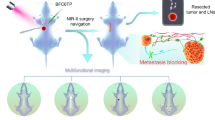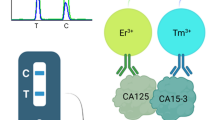Abstract
Purpose
Tumor proteases have been recognized as significant regulators in the tumor microenvironment, but the current strategies for in vivo protease imaging have tended to focus on the development of a probe design rather than the investigation of a novel imaging strategy by leveraging the imaging technique and probe. Herein, it is the first report to investigate the ability of multispectral photoacoustic imaging (PAI) to estimate the distribution of protease cleavage sites inside living tumor tissue by using an activatable photoacoustic (PA) probe.
Procedures
The protease MMP-2 is selected as the target. In this probe, gold nanocages (GNCs) with an absorption peak at ~ 800 nm and fluorescent dye molecules with an absorption peak at ~ 680 nm are conjugated via a specific enzymatic peptide substrate. Upon enzymatic activation by MMP-2, the peptide substrate is cleaved and the chromophores are released. Due to the different retention speeds of large GNCs and small dye molecules, the probe alters its intrinsic absorption profile and produces a distinct change in the PA signal. A multispectral PAI technique that can distinguish different chromophores based on intrinsic PA spectral signatures is applied to estimate the signal composition changes and indicate the cleavage interaction sites. Finally, the multispectral PAI technique with the activatable probe is tested in solution, cultured cells, and a subcutaneous tumor model in vivo.
Results
Our experiment in solution with enzyme ± inhibitor, cell culture ± inhibitor, and in vivo tumor model with administration of the developed probe ± inhibitor demonstrated the probe was cleaved by the targeted enzyme. Particularly, the in vivo estimation of the cleavage site distribution was validated with the result of ex vivo immunohistochemistry analysis.
Conclusions
This novel synergy of the multispectral PAI technique and the activatable probe is a potential strategy for the distribution estimation of tumor protease activity in vivo.






Similar content being viewed by others
References
Hanahan D, Weinberg RA (2011) Hallmarks of cancer: the next generation. Cell 144:646–674
Quail DF, Joyce JA (2013) Microenvironmental regulation of tumor progression and metastasis. Nat Med 19:1423–1437
Razgulin A, Ma N, Rao J (2011) Strategies for in vivo imaging of enzyme activity: an overview and recent advances. Chem Soc Rev 40:4186–4216
Ding S, Blue RE, Morgan DR, Lund PK (2014) Comparison of multiple enzyme activatable near infrared fluorescent molecular probes for detection and quantification of inflammation in murine colitis models. Inflamm Bowel Dis 20:363–377
Yang H-J, Kong Y, Cheng Y, Janagama H, Hassounah H, Xie H, Rao J, Cirillo JD (2017) Real-time imaging of Mycobacterium tuberculosis, using a novel near-infrared fluorescent substrate. J Infect Dis 215:405–414
Gu K, Xu Y, Li H, Guo Z, Zhu S, Zhu S, Shi P, James TD, Tian H, Zhu WH (2016) Real-time tracking and in vivo visualization of β-galactosidase activity in colorectal tumor with a ratiometric near-infrared fluorescent probe. J Am Chem Soc 138:5334–5340
Kim Y-P, Daniel WL, Xia Z, Xie H, Mirkin CA, Rao J (2010) Bioluminescent nanosensors for protease detection based upon gold nanoparticle-luciferase conjugates. Chem Commun 46:76–78
Zeng T, Zhang T, Wei W, Li Z, Wu D, Wang L, Guo J, He X, Ma N (2015) Compact, programmable, and stable biofunctionalized upconversion nanoparticles prepared through peptide-mediated phase transfer for high-sensitive protease sensing and in vivo apoptosis imaging. ACS Appl Mater Interfaces 7:11849–11856
Chuang C-H, Chuang K-H, Wang H-E, Roffler SR, Shiea JT, Tzou SC, Cheng TC, Kao CH, Wu SY, Tseng WL, Cheng CM, Hou MF, Wang JM, Cheng TL (2012) In vivo positron emission tomography imaging of protease activity by generation of a hydrophobic product from a noninhibitory protease substrate. Clin Cancer Res 18:238–247
Kondo N, Temma T, Deguchi J, Sano K, Ono M, Saji H (2015) Development of PEGylated peptide probes conjugated with 18F-labeled BODIPY for PET/optical imaging of MT1-MMP activity. J Control Release 220:476–483
van Duijnhoven SM, Robillard MS, Hermann S et al (2014) Imaging of MMP activity in postischemic cardiac remodeling using radiolabeled MMP-2/9 activatable peptide probes. Mol Pharm 11:1415–1423
Gallo J, Kamaly N, Lavdas I, Stevens E, Nguyen QD, Wylezinska-Arridge M, Aboagye EO, Long NJ (2014) CXCR4-targeted and MMP-responsive iron oxide nanoparticles for enhanced magnetic resonance imaging. Angew Chem Int Ed 53:9550–9554
Ansari C, Tikhomirov GA, Hong SH, Falconer RA, Loadman PM, Gill JH, Castaneda R, Hazard FK, Tong L, Lenkov OD, Felsher DW, Rao J, Daldrup-Link HE (2014) Development of novel tumor-targeted theranostic nanoparticles activated by membrane-type matrix metalloproteinases for combined cancer magnetic resonance imaging and therapy. Small 10:566–575
Yuan Y, Ge S, Sun H, Dong X, Zhao H, An L, Zhang J, Wang J, Hu B, Liang G (2015) Intracellular self-assembly and disassembly of 19F nanoparticles confer respective “off” and “on” 19F NMR/MRI signals for legumain activity detection in zebrafish. ACS Nano 9:5117–5124
Wang LV, Hu S (2012) Photoacoustic tomography: in vivo imaging from organelles to organs. Science 335:1458–1462
Taruttis A, Ntziachristos V (2015) Advances in real-time multispectral optoacoustic imaging and its applications. Nat Photonics 9:219–227
Nie L, Chen X (2014) Structural and functional photoacoustic molecular tomography aided by emerging contrast agents. Chem Soc Rev 43:7132–7170
Kim C, Favazza C, Wang LV (2010) In vivo photoacoustic tomography of chemicals: high-resolution functional and molecular optical imaging at new depths. Chem Rev 110:2756–2782
Barrett AJ, Woessner JF, Rawlings ND (2012) Handbook of proteolytic enzymes. Elsevier
Levi J, Kothapalli SR, Ma T-J, Hartman K, Khuri-Yakub BT, Gambhir SS (2010) Design, synthesis, and imaging of an activatable photoacoustic probe. J Am Chem Soc 132:11264–11269
Levi J, Kothapalli S-R, Bohndiek S, Yoon JK, Dragulescu-Andrasi A, Nielsen C, Tisma A, Bodapati S, Gowrishankar G, Yan X, Chan C, Starcevic D, Gambhir SS (2013) Molecular photoacoustic imaging of follicular thyroid carcinoma. Clin Cancer Res 19:1494–1502
Dragulescu-Andrasi A, Kothapalli S-R, Tikhomirov GA, Rao J, Gambhir SS (2013) Activatable oligomerizable imaging agents for photoacoustic imaging of furin-like activity in living subjects. J Am Chem Soc 135:11015–11022
Yang K, Zhu L, Nie L, Sun X, Cheng L, Wu C, Niu G, Chen X, Liu Z (2014) Visualization of protease activity in vivo using an activatable photo-acoustic imaging probe based on CuS nanoparticles. Theranostics 4:134–141
Zhang L, Gao S, Zhang F, Yang K, Ma Q, Zhu L (2014) Activatable hyaluronic acid nanoparticle as a theranostic agent for optical/photoacoustic image-guided photothermal therapy. ACS Nano 8:12250–12258
Miao Q, Pu K (2016) Emerging Designs of activatable photoacoustic probes for molecular imaging. Bioconjug Chem 27:2808–2823
Zhang Q, Li W, Moran C, Zeng J, Chen J, Wen LP, Xia Y (2010) Seed-mediated synthesis of Ag nanocubes with controllable edge lengths in the range of 30-200 nm and comparison of their optical properties. J Am Chem Soc 132:11372–11378
Zhou F, Wu S, Yuan Y, Chen WR, Xing D (2012) Mitochondria-targeting photoacoustic therapy using single-walled carbon nanotubes. Small 8:1543–1550
Lalwani G, Cai X, Nie L et al (2013) Graphene-based contrast agents for photoacoustic and thermoacoustic tomography. Photo-Dermatology 1:62–67
Pu K, Shuhendler AJ, Jokerst JV, Mei J, Gambhir SS, Bao Z, Rao J (2014) Semiconducting polymer nanoparticles as photoacoustic molecular imaging probes in living mice. Nat Nanotechnol 9:233–239
Jokerst JV, Thangaraj M, Kempen PJ, Sinclair R, Gambhir SS (2012) Photoacoustic imaging of mesenchymal stem cells in living mice via silica-coated gold nanorods. ACS Nano 6:5920–5930
Duan S, Yang Y, Zhang C, Zhao N, Xu FJ (2017) NIR-responsive polycationic gatekeeper-cloaked hetero-nanoparticles for multimodal imaging-guided triple-combination therapy of cancer. Small 13
Hu Y, Wen C, Song L, Zhao N, Xu FJ (2017) Multifunctional hetero-nanostructures of hydroxyl-rich polycation wrapped cellulose-gold hybrids for combined cancer therapy. J Control Release 255:154–163
Wang R, Zhao N, Xu FJ (2017) Hollow nanostars with photothermal gold caps and their controlled surface functionalization for complementary therapies. Adv Funct Mater 27
Song L, Zhao N, Xu FJ (2017) Hydroxyl-rich polycation brushed multifunctional rare-earth-gold core–shell nanorods for versatile therapy platforms. Adv Funct Mater 27
Zhao N, Li J, Zhou Y, Hu Y, Wang R, Ji Z, Liu F, Xu FJ (2016) Hierarchical nanohybrids of gold nanorods and PGMA-based polycations for multifunctional theranostics. Adv Funct Mater 26:5848–5861
Li W, Brown PK, Wang LV, Xia Y (2011) Gold nanocages as contrast agents for photoacoustic imaging. Contrast Media Mol Imaging 6:370–377
Yang X, Skrabalak SE, Li Z-Y, Xia Y, Wang LV (2007) Photoacoustic tomography of a rat cerebral cortex in vivo with Au nanocages as an optical contrast agent. Nano Lett 7:3798–3802
Song KH, Kim C, Cobley CM et al (2008) Near-infrared gold nanocages as a new class of tracers for photoacoustic sentinel lymph node mapping on a rat model. Nano Lett 9:183–188
Kim C, Cho EC, Chen J, Song KH, Au L, Favazza C, Zhang Q, Cobley CM, Gao F, Xia Y, Wang LV (2010) In vivo molecular photoacoustic tomography of melanomas targeted by bioconjugated gold nanocages. ACS Nano 4:4559–4564
Xia X, Yang M, Oetjen LK et al (2011) An enzyme-sensitive probe for photoacoustic imaging and fluorescence detection of protease activity. Nano 3:950–953
Roy R, Yang J, Moses MA (2009) Matrix metalloproteinases as novel biomarkers and potential therapeutic targets in human cancer. J Clin Oncol 27:5287–5297
Yu M, Zheng J (2015) Clearance pathways and tumor targeting of imaging nanoparticles. ACS Nano 9:6655–6674
Herzog E, Taruttis A, Beziere N, Lutich AA, Razansky D, Ntziachristos V (2012) Optical imaging of cancer heterogeneity with multispectral optoacoustic tomography. Radiology 263:461–468
Galanzha EI, Shashkov EV, Spring PM, Suen JY, Zharov VP (2009) In vivo, noninvasive, label-free detection and eradication of circulating metastatic melanoma cells using two-color photoacoustic flow cytometry with a diode laser. Cancer Res 69:7926–7934
Kim C, Song KH, Gao F, Wang LV (2010) Sentinel lymph nodes and lymphatic vessels: noninvasive dual-modality in vivo mapping by using indocyanine green in rats—volumetric spectroscopic photoacoustic imaging and planar fluorescence imaging. Radiology 255:442–450
Skrabalak SE, Au L, Li X, Xia Y (2007) Facile synthesis of Ag nanocubes and Au nanocages. Nat Protoc 2:2182–2190
Jiang T, Olson ES, Nguyen QT, Roy M, Jennings PA, Tsien RY (2004) Tumor imaging by means of proteolytic activation of cell-penetrating peptides. Proc Natl Acad Sci U S A 101:17867–17872
Olson ES, Aguilera TA, Jiang T, Ellies LG, Nguyen QT, Wong EH, Gross LA, Tsien RY (2009) In vivo characterization of activatable cell penetrating peptides for targeting protease activity in cancer. Integr Biol 1:382–393
Cho EC, Kim C, Zhou F, Cobley CM, Song KH, Chen J, Li ZY, Wang LV, Xia Y (2009) Measuring the optical absorption cross sections of Au-Ag nanocages and Au nanorods by photoacoustic imaging. J Phys Chem C 113:9023–9028
Taraboletti G, D'Ascenzo S, Borsotti P, Giavazzi R, Pavan A, Dolo V (2002) Shedding of the matrix metalloproteinases MMP-2, MMP-9, and MT1-MMP as membrane vesicle-associated components by endothelial cells. Am J Pathol 160:673–680
Chau Y, Padera RF, Dang NM, Langer R (2006) Antitumor efficacy of a novel polymer-peptide-drug conjugate in human tumor xenograft models. Int J Cancer 118:1519–1526
Acknowledgments
The authors acknowledge the use of the University Research Facility in Life Sciences (ULS).
Conflict of Interest
The authors declare that they have no conflict of interest.
Funding
This work was supported in part by the Hong Kong Innovation and Technology Fund (GHP/009/14SZ); Shenzhen Science, Technology and Innovation Commission research grant (SGLH20150216172854731); Health and Medical Research Fund of Food and Health Bureau of Hong Kong (01121836 and 03144266); National Natural Science Foundations of China (11674271); and The Hong Kong Polytechnic University internal grant (4-BCAP and 4-BCDP).
Author information
Authors and Affiliations
Corresponding author
Electronic supplementary material
ESM 1
(PDF 1350 kb)
Rights and permissions
About this article
Cite this article
Liu, C., Li, S., Gu, Y. et al. Multispectral Photoacoustic Imaging of Tumor Protease Activity with a Gold Nanocage-Based Activatable Probe. Mol Imaging Biol 20, 919–929 (2018). https://doi.org/10.1007/s11307-018-1203-1
Published:
Issue Date:
DOI: https://doi.org/10.1007/s11307-018-1203-1




